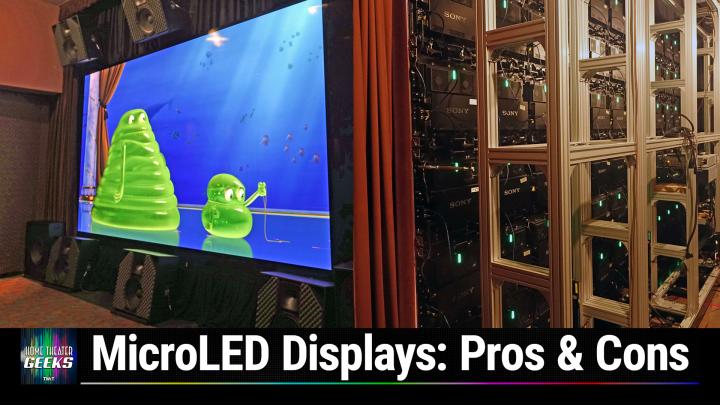Unpacking MicroLED for TVs
AI Created, human edited.
In a recent episode of Home Theater Geeks, host Scott Wilkinson dives deep into the world of MicroLED technology, addressing a listener's question about LED video walls as TVs. As the technology gains traction in the consumer market, Wilkinson provides a comprehensive overview of its potential and limitations.
MicroLED: A Brief History
MicroLED isn't entirely new. For years, we've seen large LED video walls in sports stadiums and as outdoor signage in places like Las Vegas. However, the LEDs used in these applications are much larger and spaced further apart than those in MicroLED displays designed for home use.
The Technology Behind MicroLED
MicroLED displays use tiny red, green, and blue LEDs emitting light to form images. These LEDs are small – often just a few microns in diameter – and are placed very close together. Wilkinson cites Sony's approach, where each pixel's light source occupies only 0.003 square millimeters, surrounded by black space for improved contrast.
The Modular Approach
Most MicroLED displays for home and professional use are built using smaller tiles, typically measuring one to two feet square. These tiles are mounted together and connected electronically to create larger displays. This modular approach allows for screens of various sizes and aspect ratios, with resolution increasing as more tiles are added.
Advantages of MicroLED
- Brightness: MicroLED displays can achieve incredible brightness levels, with some prototypes reaching up to 10,000 nits – far surpassing current OLED and LED-LCD TVs.
- Contrast: Like OLED, MicroLED is self-emitting and can achieve perfect blacks, resulting in essentially infinite contrast ratios.
- Longevity: MicroLEDs degrade less over time compared to OLED materials, potentially offering a longer lifespan.
- Scalability: The modular nature of MicroLED allows for creating extremely large displays limited only by budget and space.
Challenges and Disadvantages
- Manufacturing Difficulties: Producing MicroLED displays is exceptionally challenging, with perfect LED placement required for each tile. This results in low manufacturing yields and high costs.
- Visible Seams: Despite advancements, the seams between tiles can still be visible under certain conditions, detracting from the viewing experience.
- Audio Integration: Unlike projection screens, MicroLED displays can't have speakers placed behind them, leading to potential audio-visual mismatches.
- Cost: The most significant barrier to adoption is that MicroLED displays are prohibitively expensive for most consumers. Wilkinson cites a recent Samsung 89-inch MicroLED TV priced at $102,000.
The Future of MicroLED
While Wilkinson believes MicroLED could be the "ultimate display technology for the home" if manufacturers can solve the seam visibility issue and significantly reduce costs, he doesn't expect this to happen for quite some time. In the foreseeable future, MicroLED displays will likely remain in the domain of ultra-wealthy and high-end commercial installations.
For everyday consumers, Wilkinson still recommends OLED as the best current option, offering excellent picture quality and sufficient brightness for most viewing situations.
Want to learn more about the latest in display technology? Listen to the full episode of Home Theater Geeks with Scott Wilkinson for an in-depth exploration of MicroLED and other cutting-edge developments in home theater.
